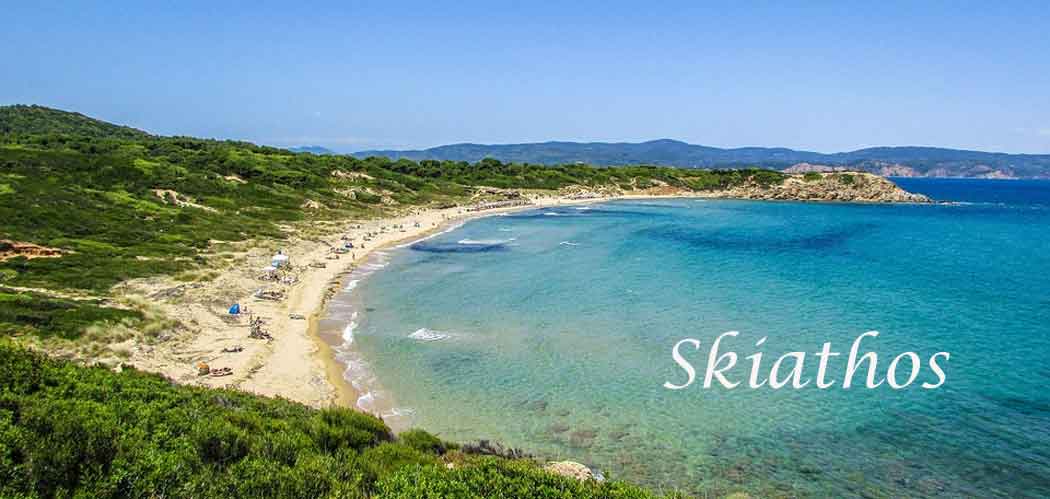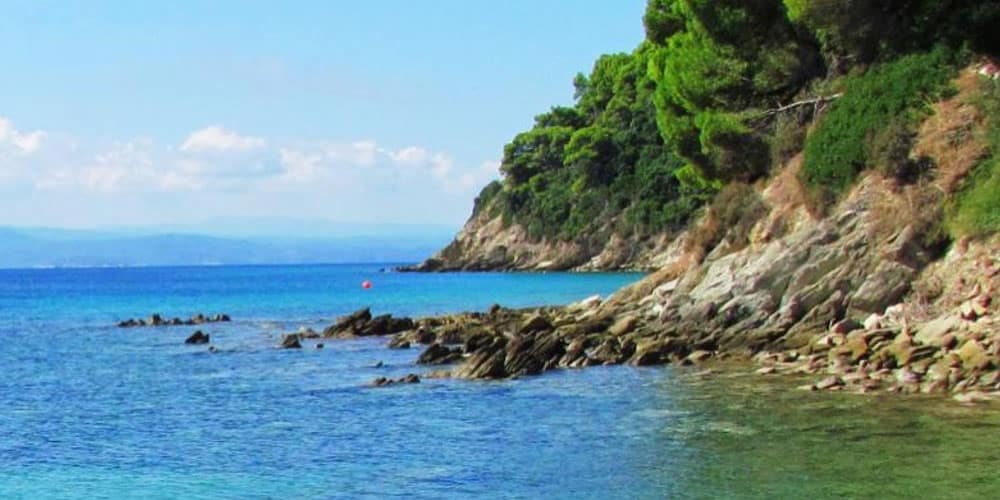Information about the island of Skiathos
Skiathos used to be a jet set island favoured by the rich and famous who arrived here on luxury yachts, lured by some of the Mediterranean’s best beaches.
You’ll still find a fair number of sleek yachts bobbing in the harbour and cruising the coastline but the advent of an international airport has transformed Skiathos into tour operator territory.
Most hotels here are block booked by the package holiday industry more than a year in advance so you’d be unwise to pitch up without a reservation in high season.
If you come by boat you’ll arrive at Skiathos Town on the eastern side of the island where much of the holiday accommodation and nightlife are centred. The place is awash with bars, banks, internet cafes, shops, restaurants and various other tourist paraphernalia.
Much of the old part of the town was destroyed by German bombs in WW2 but if you explore the narrow cobbled streets set back from the waterfront you’ll find the place still has its charms.
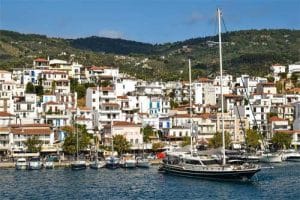
Skiathos is a small and compact island, just 12km long and about 6km wide, and its main claim to fame is a plethora of large, deep, sandy beaches strung right the way along its southern coastline.
Recent years have seen an explosion in tourist facilities and, nowadays, a virtually unbroken line of hotels, apartments and neon-lit tavernas flank the once rural road that runs the length of the south coast.
A ban on high rise hotels has curbed major downmarket excess but Skiathos still groans under its own weight in annual tourist numbers.
The island’s ever growing popularity has resulted in higher prices in the popular resorts and the inevitable drift to dumbed down tackiness.
History
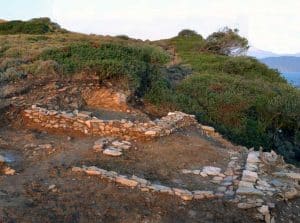
.
After the Pelasgians, the Cretans came to the island, who brought olive and grape cultivation. The history of Skiathos has many ups and downs, it went through years of prosperity and decline, but managed to stand through the ages.
Skiathos was to fall under Athenian, Spartan as well as Macedonian rule through the ancient years. The greatest catastrophy came when Philip III sacked the island in order to prevent the invading Romans from getting the island’s riches in the 2nd century BC. Skiathos was to enjoy relative freedom both under Roman and Byzantine times until the Venetian Ghisi brothers took it over in the 13th century.
The curse of the island was the constant pirate raids during Medieval times. The people of the island moved to Kastro, and did their best to protects themselves from there. The final blow came in 1538 when the Turks invade. After defending themselves for a week, the Skiathos people could no longer resist, and the Turks stormed into Kastro, killing men, women and children.
The Turkish rule was strict, and many refugees also came from the mainland, impoverishing Skiathos almost totally. The island was finally freed in 1829. Since then it has been a peaceful place, with the exception of the Second World War when the Germans set the island on fire.
Culture and tradition
The culture of Skiathos is a blend of traditional Greek values and modern influences, deeply rooted in history, art, and community life. The island’s traditions are a vivid testament to its rich history, with many cultural practices and festivities that have been preserved through generations. The people of Skiathos, known for their hospitality and warmth, play a crucial role in keeping these traditions alive, ensuring that the island’s heritage continues to thrive alongside its contemporary developments.
One of the most striking aspects of Skiathian culture is its religious festivals and celebrations, which are integral to the island’s social fabric. These events, often associated with the Greek Orthodox Church, feature prominently in the island’s calendar. The feast of the Assumption of the Virgin Mary on August 15th is one such celebration, drawing both locals and visitors to participate in religious services, processions, and communal feasts. These occasions are not only a display of devotion but also a time for community bonding, showcasing traditional music, dance, and culinary delights.
The culture, traditions, and people of Skiathos form the backbone of this enchanting island, making it much more than just a holiday destination. It’s a place where history comes alive in the everyday, where traditions are celebrated with joy and fervour, and where the warmth of the people makes every visitor feel at home. Skiathos invites those who tread its shores to delve deeper into its cultural heritage, offering an experience that is as enriching as it is enjoyable.
Towns and setlements
Skiathos town
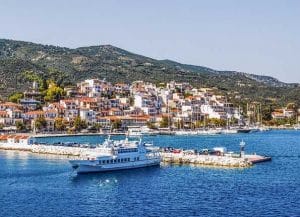
The town of Skiathos is the only settlement on the island. It is built on the southeast end of the island in a sheltered bay that divides the island of Bourtzi into two parts. It is a relatively new settlement, built in 1829-1830 on the site of the ancient city, on two hills lying at the edge of the sea. They had founded the ancient settlement in 800 BC.
Beautiful and picturesque, the island’s capital and port, Skiathos, is flooded with tourists every summer. Built amphitheatrically with whitewashed houses, it hosts most of the island’s permanent residents since there is no other settlement apart from the scattered farmhouses throughout the island. At the entrance of the port we are greeted by Mpourtzi, the ruins of the Venetian fortress on the pine-covered islet. The picture is completed by the windmill and the churches of Mitropolis, Panagia Limnia and Agios Nikolaos. Along the beach, but also in the narrow alleys, you will find many taverns, restaurants, ouzo, bars and shops for your shopping and entertainment.
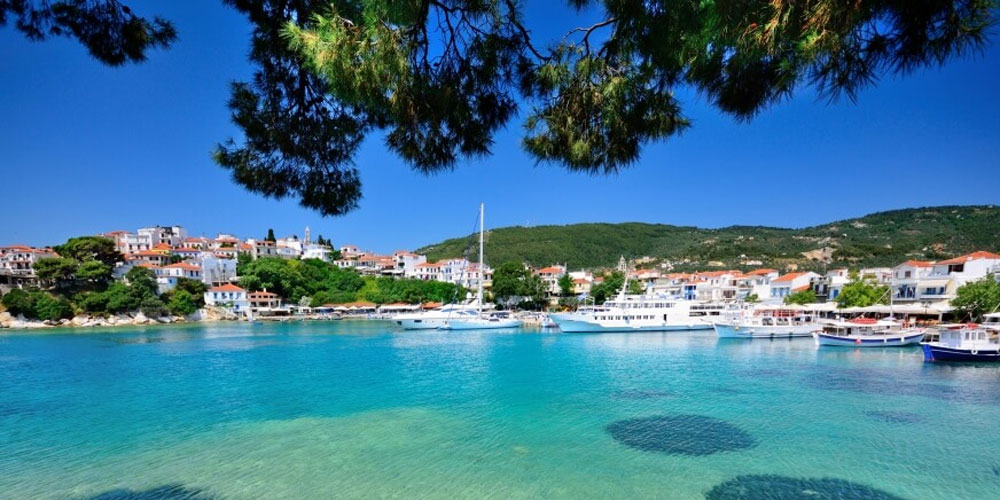
Important are the cultural events “Dream on the Wave”, in Mpourtzi, which are held every two years by the Skiathos Development Association and last all three months of the summer. As part of these events, lectures, theater performances, film screenings, concerts are organized. It is worth getting the detailed program of the events held at the Open Theater and the Municipal Music Cafe in Mpourtzi. If you find yourself in Skiathos in July, don’t miss the musical events organized as part of the Maritime Week.
Also, during the summer, there is a folklore exhibition in a municipal pavilion with objects of the old household, traditional textiles, furniture where you will be able to buy local homemade sweets. The eve of Ai-Yiannis revives the custom of Klidonas, while in September the “Katsonia” takes place, with a memorial prayer at the place where the submarine “Lambros Katsonis” sunk. It is worth watching the folk horse races that take place on the day of St. George.
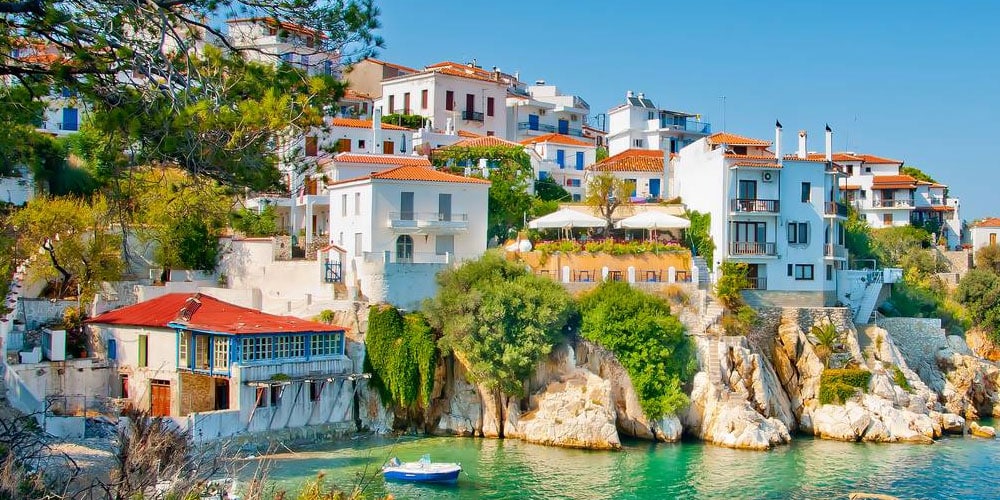
The sandy beaches of Skiathos are enchanting, with crystal clear waters and natural shade from the pine trees that in many cases reach almost to the water. Near the city you will swim in Mpourtzi. You can reach most of the island’s beaches by boat or by road. In the series you will meet Megali Ammos, Achladies, one of the best beaches of the island, Tzaneries, another cove with a sandy beach, and you will end up in Kanapitsa and Troullos with equally wonderful beaches and beautiful tavernas.
Achladies and Kanapitsa have excellent tourist infrastructure. On the south side of the island, 6 km from Chora, is the beach of Agia Paraskevi. The white gold sand, the crystal clear waters and the rich vegetation will impress you. The excursion boats moored at the port of Skiathos can also take you to the Blue Cave and the Dark Cave in the northern part of the island, which offer a fascinating sight, in Lalaria the impressive beach with round white pebbles, in Trypia Petra an impressive vertical eroded rock , in Kastro, but also in Tsougria, the green island with the pristine sandy beach opposite Achladies.
Koukounaries
A place famous for its beach, considered one of the best in Europe, with pine trees where the pine trees touch the sea. It is located 12 km southwest of Skiathos. Just behind the sea, lies Strofilia lake like a mirror of the blue. To the right, the canal and the small marina for boats and fishing boats give their own color.
The habitat of Koukounaria is one of the three most important habitats of our country. There are three main features of this unique habitat: the sandy beach, the Koukounaria forest (pinus pinea) and the lake with semi-fresh water.
The condition of the lake was studied by the scientific center of marine research and restoration works were carried out in the lakeside zone so that many migratory birds such as swans, egrets and various species of ducks could spend the winter finding a welcoming shelter in the habitat. Other bird species breed on the banks, such as the black petrel, the plover and the night raven. West of Koukounaries you will find the beaches of Banana, Krassa, Aselino, Agia Eleni and further north in the exotic Mandraki. All are beautiful, green and spotlessly clean.
Agia Paraskevi
On the south side of the island and at a distance of 6 km from the city is the wonderful beach of Agia Paraskevi. The clear blue waters, the golden sand and the green landscape enchant the visitors.
The area takes its name from the small church of Agia Paraskevi, which is located there. On this beach there are luxury hotels, taverns and you can engage in all kinds of water sports.
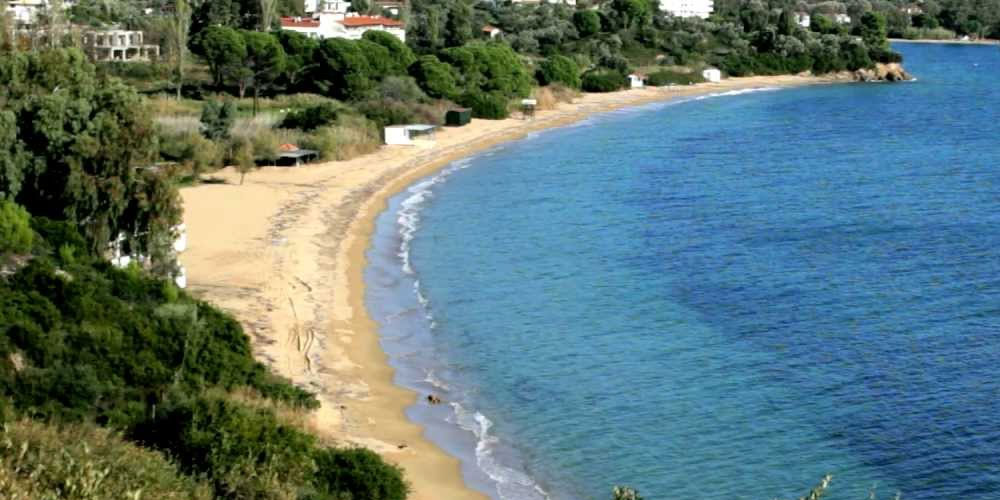
Achladies
Seaside area, which is two kilometers from the town of Skiathos and its beach is one of the most popular on the island. It is organized with deckchairs and umbrellas and with water sports possibilities.
You can get there by car or bus, but also by boat, which runs regular routes from the port of Skiathos. Achladies is beautiful and fully utilized, as there are beautiful taverns, hotels and rooms for rent. Following it, we come across the closed bay of Tzaneria.
The area boasts several traditional tavernas and cafes where you can sample delicious Greek dishes, seafood, and other Mediterranean delicacies. The laid-back atmosphere of these eateries adds to the charm, offering a relaxed dining experience with stunning sea views.
In terms of accommodation, Achladies has a range of options to cater to different preferences and budgets. From luxury resorts and villas to more modest apartments and studios, visitors can find a comfortable place to stay while exploring Skiathos. Many of these accommodations offer fantastic views over the Aegean Sea, adding to the memorable experience of staying in this beautiful area.
The proximity of Achladies to Skiathos Town, which is just a short drive away, is another advantage. Visitors can easily travel to the island’s capital to explore its vibrant nightlife, historical sites, and shopping venues, before returning to the peaceful retreat of Achladies.
Furthermore, Achladies serves as a good base to explore other beautiful beaches and natural sights on Skiathos. With a convenient location and good transportation links, it’s easy to venture out and discover more of what the island has to offer.
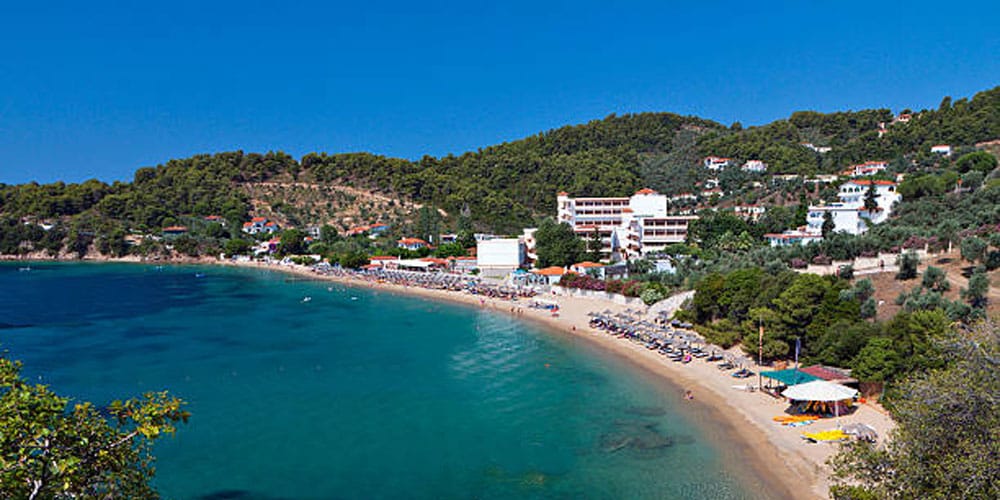
Vasilias
Vasilias is a charming and peaceful area in Skiathos that offers a blend of relaxation, beautiful natural scenery, and proximity to more lively and bustling areas of the island. It’s a delightful spot for those seeking to experience the authentic beauty and tranquility of the Aegean Sea.
Vasilias is not far from Skiathos Town, the island’s capital, which is just a short drive away. This proximity allows visitors to easily explore the lively atmosphere, charming streets, and vibrant nightlife of Skiathos Town, yet return to the tranquility of Vasilias for a peaceful night’s sleep.
Furthermore, the area serves as a great base to explore other parts of Skiathos Island. With the island being relatively small, it’s easy to venture out to discover the many other beautiful beaches, historical sites, and natural landscapes Skiathos has to offer.
The local cuisine in Vasilias is something that should not be missed. The tavernas and restaurants in and around the area serve a variety of delectable local and Mediterranean dishes. Whether dining by the sea or in the quaint village setting, the culinary experience in Vasilias is sure to be delightful.
For those interested in water sports and outdoor activities, the neighboring beaches offer a variety of options such as sailing, windsurfing, and kayaking.
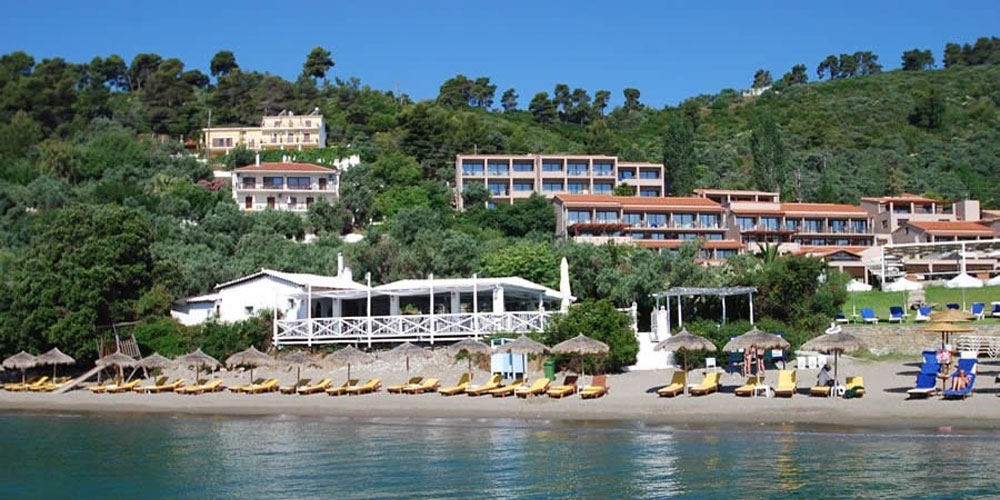
Kanapitsa
Kanapitsa is considered a suburb of Skiathos. It is located on the south-eastern side of the island and is 7 km from the city. In recent years, the area has been developing touristically. Around the peninsula of the same name and its beach, there are many luxury hotels and complexes of rooms for rent.
Its beach is one of the most popular on the island. Its golden sand will impress you. It is organized with many water sports possibilities. There is also a diving school in the area. Access is easy by bus, taxi, private, or car.
The area around Kanapitsa is dotted with charming hotels, villas, and apartments that provide comfortable accommodations with magnificent views of the Aegean Sea. Many of these establishments are family-run, offering warm, hospitable services that reflect the friendly nature of the local people.
Kanapitsa is also home to a quaint little marina where boats and water taxis dock. The water taxi service provides a convenient and enjoyable way to travel to Skiathos Town and other nearby beaches. It’s a unique experience to explore the island from the sea, giving visitors a different perspective of Skiathos’ beautiful coastline.
The area has a few tavernas and cafes where visitors can enjoy delicious Greek cuisine and seafood. Dining in a seaside taverna while watching the sunset is a memorable experience that many visitors cherish.
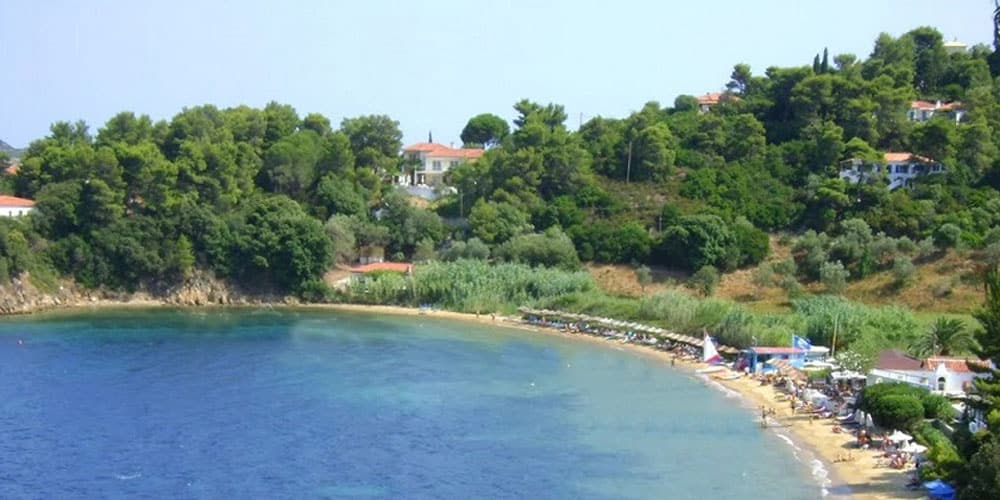
Troulos
The small coastal settlement of Troulos with its beautiful beach is located 8 km south of the city. Just opposite the bay of the same name are the Troulonisia. This beach takes its name from the islet that is located there and looks like a dome. It is located on the road to Koukounaries, immediately after the intersection that leads to the Monastery of Ikonistrias.
You can reach Troulos by road and enjoy its clear blue-green waters and the shade of the pine trees that reach next to the sea. In Trullo there are many hotels, guesthouses and taverns.
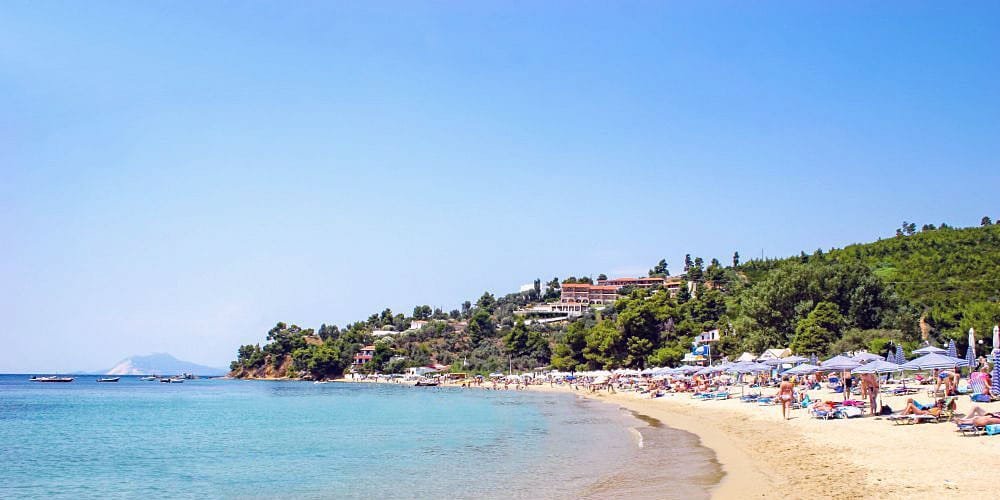
Natural attractions
Skiathos has been designated a place of national value and has remarkable beaches, rich vegetation, picturesque paths, historical monuments and traditional architecture in an internationally recognized natural environment with many protected areas that every visitor should get to know.
Strofilia Lake
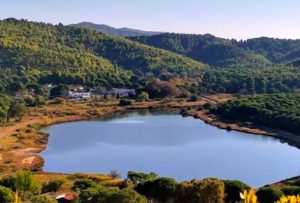
The area around Strofilia Lake is a protected wetland, and its ecological significance has been acknowledged with various conservation measures to preserve the indigenous flora and fauna. The wetland hosts a variety of bird species, both migratory and resident, making it a favorable spot for birdwatching. Some of the bird species you might encounter include herons, swans, and ducks.
The rich vegetation surrounding the lake comprises primarily of pine trees, which provide a cooling shade and contribute to the serene ambiance of the area. The juxtaposition of the dense pine forest, tranquil lake waters, and nearby Aegean beaches create a picturesque scenery that’s perfect for relaxation and outdoor exploration.
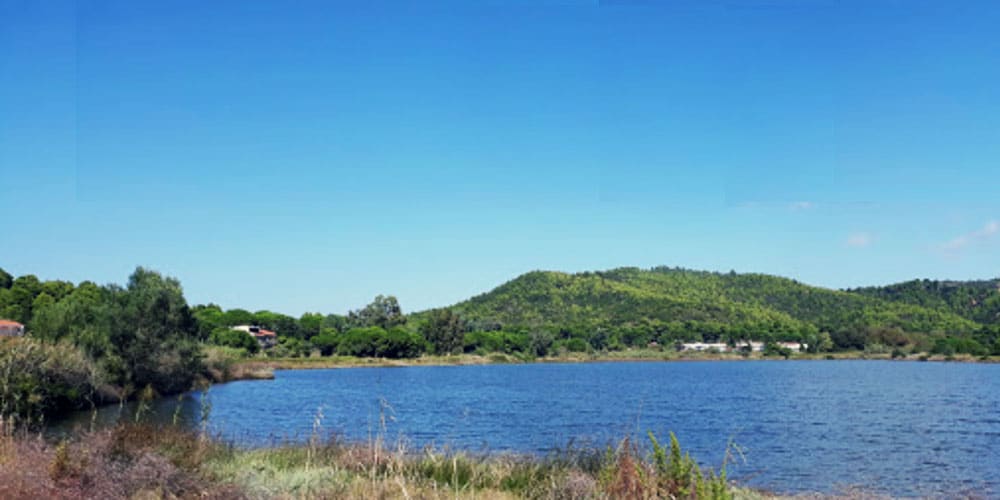
Trails around the lake offer visitors the opportunity to delve into the natural beauty of Skiathos. Walking around the lake, visitors can enjoy the peaceful environment, observe the wildlife, and indulge in photography capturing the enchanting landscape.
Despite its quiet demeanor, Strofilia Lake is accessible as it’s located close to the popular Koukounaries beach. Visitors to the beach often take the opportunity to explore the lake and its surroundings. The location also provides a respite from the bustling beach crowds, especially during the high summer season, offering a more secluded and tranquil experience.
Skiathos Forests
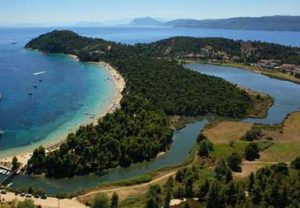
The area where the Forest of Skiathos is located is a fully protected area – that is, construction activities or interventions are prohibited with few exceptions. The area includes the Koukounaria Forest as well as part of the area of the Holy Monastery of Evangelistria.
Wildlife Refuges
Wildlife Refuges are defined as “natural areas that are of particular importance as important places for the growth of wild flora or as breeding, feeding and wintering habitats for wild fauna species or as fish breeding and spawning areas or, finally, as important marine habitats” . Two areas on the island of Skiathos have been established as Wildlife Refuges: the site of Kehria (1722 acres) and the site of Koukounaries (168 acres).
Small Island Wetlands
On the island of Skiathos, the Vromolimnos wetland, with an area of 19 acres, the Elos Platanias, with an area of 30 acres, as well as Tsougrias, the wonderful island opposite the old port of Skiathos, have been designated as wetlands of absolute protection. Behind its pine forest, the lake of Strofilia is a unique habitat with rare species of birds. Be sure to visit the sea caves.
Natura 2000 areas
The European Union has enacted legislation for the protection of nature which was developed with the Natura 2000 ecological network in mind, the aim of which is to protect endangered species.
In the Municipality of Skiathos, the area “Koukounaries and the wider marine area” belongs to the Natura 2000 ecological network and covers an area of over 888 acres. This is the only Koukounaria habitat on an island in the Mediterranean. It is located in the southern part of the island and includes the forest of Strofilia, its coastal and marine zone.
The total area is bounded to the north, east and west by the road network and to the south it reaches the sea at a depth of 20 meters and its height does not exceed 1.5 meters.
Places to visit in Skiathos
The Byzantine Castle of Skiathos
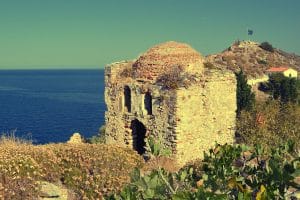
Skiathos Castle (Kastro) was built as a refuge from marauding pirates, notably the Barbarossa brothers, and commands a dramatic position over the sea. the Kastro used to house more than 20 churches and 300 odd homes.
Only two churches have survived the ravages of time and the several half-hearted attempts at restoration. Also remaining are part of the wall and gate of the old fort as well as a half-ruined mosque and a cannon. A wooden drawbridge has been replaced by a flight of cement steps and a house has been rebuilt.
You can get to the Kastro on foot but it is a good three-hour walk. Most take one of the excursion boats that make the trip daily from Skiathos town and drop passengers at the bottom of a long series of steps up the cliff. There is a flat beach here of shingle and stone and a ramshackle beach taverna that gets packed out as the boats arrive. Nearby, and accessible only by boat, are three sea grottos, named Galazia (Blue), Skotini (Dark) and Chalkini (Copper).
Offshore islets of Skiathos
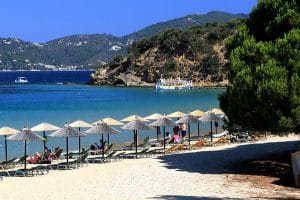
The most popular is Tsougria which lies directly south of Skiathos Town, is the biggest and also enjoys two pleasant beaches. The best one lies in a sheltered bay of shallow water, making it the one that most families with children head for.
A small beach cantina opens in the summer months for refreshments and snacks. The alternative beach is on the other side of the islet and involves a walk over the headland or a longer boat ride, though visitors must take care to avoid some underwater rocks that can make mooring a little difficult.
To the west of Tsougria is the smaller rocky islet of Tsougriaki which doesn’t have a beach although visitors often tie up for an afternoon of peaceful swimming in one of the many coves.
Northeast, and nearer the coast is the islet of Arkos. Day trip boats don’t go here so you need to rent your own but there is a small beach there with a cantina that opens during the summer.
Monasteries of Skiathos
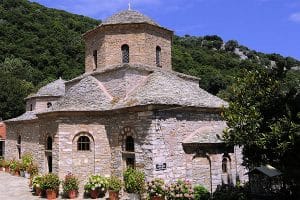
Evangelistria is about five kilometres north of Skiathos town and buried in the most beautiful countryside. You can’t see the monastery until you are on top of it.
Founded in 1794 it was finished around 1806. It has a giant footnote in Greek modern history by being the place where fighters against the Turks took their oath under the first independent Greek flag. It is a cruciform Byzantine church with three domes.
Frescoes are found in the sanctuary but the monastery’s real treasure is a magnificent carved wooden iconostasis. On August 15 the ceremony of the Burial of Our Lady is performed here.
Panagia Eikounistria is the patron of Skiathos and has several frescoes including one of Agios Christofos with a face of a dog.
The monastery of Panagia Kounistra is just above Troulos and is where the holy icon of Panagia Kounistra patron of Skiathos was found. It is set in a very pretty spot, has a grape arbour and a taverna within its walls. It has a beautiful gilt wooden iconostasis decorated with vine-leaves and grapes.
Things to do
Plane spotting at the airport of Skiathos

Dozens of people were at the spot for their favorite hobby, plane spotting, with Skiathos Airport being one of the most popular destinations for plane spotting. The airport’s runway is quite short and is situated extremely close to the public road and the adjacent seafront, which makes it a thrilling location for watching aircraft operations up close. The layout of the airport allows spectators to experience the thrill of low landings and take-offs, akin to the famous Maho Beach viewing spot near Princess Juliana International Airport in St. Maarten.
Nightlife
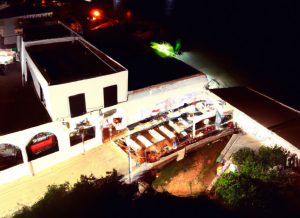
The waterfront area is also bustling with beach bars and clubs that offer fantastic sea views, live music, and DJ sets. Whether you’re in the mood for dancing the night away or enjoying a relaxed drink under the stars, Skiathos nightlife will leave you with memories to cherish.
Beaches
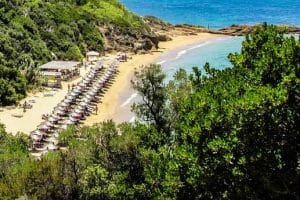
If you want to escape the madding crowds and explore the island’s interior you’ll find a hikers’ paradise of hidden valleys, deserted monasteries and lonely trails where the wild birds are likely to be your only company. It’s also possible to find quiet, secluded coves if you’re prepared to stray some distance from the beaten track.
Skiathos is noted among the Greek islands for its profusion of soft sandy beaches. The whole south coast of this small island is a succession of sandy coves, most now given over to heavy commercialism.
Quiet and deserted coves are few, with the Kalamaki Peninsula offering the best chance of a day away from the crowds.
The few north coast beaches have avoided the exploitation seen in the south but they are less easy to reach.
Most of Skiathos’ golden sand beaches are strung along the island’s south coast.
Well sheltered from the northerly meltemi wind, many are set in medium sized coves and backed by pine draped hills.
They are as thick on the ground as the tourists and are all serviced by the single asphalt road that runs the length of the island.
Some beaches are backed by low rise hotels and many get overwhelmed with tourists. Most enjoy deep sand, shallow seas and the usual tourist facilities.
Where to Stay in Skiathos
Find your accommodation in or near the town if shopping is one of your main missions because there’s a huge variety of shops to choose from – chic boutiques, tacky souvenir shops, good quality arts and crafts centres and some classy jewellers.
The coastline leading south of the town as far as the south west corner of the island is lined with hotels, villas and tavernas all trying to sate the demands of the high season hordes that pack the wonderful but crowded south coast beaches.
When to go
Skiathos has a typical Mediterranean climate. April is warm and sunny although rain in the spring months can sometimes be prolonged. May brings many fine days and wild flowers are everywhere.
June through to August sees long, sunny days and high temperatures with very little rainfall. In July and August the brisk northern meltemi wind can blow strongly, freshening the air and lowering the humidity.
Winter temperatures average a mild 11°C but the wet winters can sometimes include heavy snow showers. November to January is the wettest season with monthly rainfall an average 150mm.
Getting around Skiathos
The best way to explore the interior of Skiathos is with a car or motorbike. Regular buses run between Skiathos Town and the south coast beaches in the summer months but with your own set of wheels you’ll be able to discover secluded coves around the coastline, visit the old fortress capital of Kastro and make your way to the various monasteries dotted around the island.
There are numerous car and scooter hire firms along the waterfront behind the ferry harbour. You can rent cars, jeeps, motor bikes, mopeds and mountain bikes – prices vary according to the standard of vehicle and duration of the rental period but are always higher in July and August than at other times of the year.
Many firms include insurance in the rental fee so check this point before signing on the dotted line. If you’re hiring a motorbike or scooter, make sure you get a helmet included in the price.and wear it because it’s the law and there are many fatalities and serious injuries involving foreign bikers in the Greek islands every summer.
The road north from Skiathos Town takes you to the beautifully located Evangelistria Monastery, perched 450 metres above a gorge and surrounded by pines and cypresses. Ignore the airport turn-off after you leave town and continue north towards the monastery, taking your time on the drive up to it because it’s worth stopping to admire the wonderful views en route.
The 18th century monastery was once used as a hiding place for freedom fighters during the Greek War of Independence. The fighters took their pledge of “freedom or death” here and it’s said that the first Greek flag was raised at the monastery in 1807 in defiance of the Ottoman occupiers.
To reach the abandoned hilltop fortress of Kastro you can either take the dirt track leading north west of Moni Evangelistria, if you’re using a 4×4 or mountain bike, or take the paved road which leads from Skiathos Town and stops about a 30-minute walk from the island’s former capital.
The pirate-proof town, built in the 16th century to protect the islanders from seaborne invaders, is in a spectacular location on the headland and was once only accessible via a drawbridge. The fortress consisted of 300 houses and 22 churches but only three churches remain, one of which houses some elaborate frescoes and an impressive iconostasis (the screen separating the altar from the main part of the church).
The road south from Skiathos takes you down the east coast and skirts the coastline all the way to the south west tip of the island, passing several access points to the most popular beaches including beautiful but busy Koukounaries.
You might want to stop for a delicious fresh fish lunch at the waterside Trouillos Taverna before heading inland four kilometres to the deserted 17th century Kounistra Monastery. It was built on the spot where a monk reputedly found a miraculous icon of the Virgin swinging in a pine tree.
It’s a lovely trip to the monastery which contains some fine icons, though the main one is kept in Trion Ierarchon Church in Skiathos Town. If you’re visiting in November you’ll be able to see the annual procession in which the islanders bring the icon from the town to its former home in celebration of feast day in honour of the Virgin.
Skiathos transport
There is only a single road on Skiathos and it follows the south coast snaking through or near the main south coast beach resorts. Off the main road the conditions deteriorate sharply and those heading into the hills will need a four-wheel-drive.
Renting a car in Skiathos is an excellent way to explore the island’s diverse landscapes, cultural sites, and hidden beaches at your own pace. By choosing a reputable rental agency, understanding insurance and safety regulations, and following practical tips, you can ensure a smooth and enjoyable driving experience. Whether navigating the coastal roads or venturing into the mountainous hinterland, a rental car opens up a world of discovery on this enchanting Aegean island.
Skiathos has an excellent bus service from Skiathos Town to Koukounaries. Buses roll out every 15-20 minutes in the summer and they are clean and well kept but they are crammed with tourists at busy time.
Perspiring passengers concertina up the aisle and getting off requires the tactical skills of Rommel. Homeward bound passengers will stand stoically at stops watching the packed bus loads roll by until they eventually hail a taxi or start walking. The information kiosk in front of Skiathos harbour has free photocopies of bus timetables.
Skiathos taxis
Skiathos taxis abound at the airport to pick up new arrivals and there is a taxi rank on the harbour front. Fares are regulated but drivers charge extra for going off the main road and it costs more if you phone the taxi station.
How to get to Skiathos
By Air
Skiathos Airport (JSI) is the main flight destination for visitors to the Sporades islands. The airport is about 3km north of Skiathos Town and takes charter flights from all over Europe.
There are daily domestic flights from Athens (20 minutes) and there are also flights from Volos and from Thessaloniki.
Skiathos Airport has a notoriously short runway and aircraft taking off from here only carry a minimum fuel load to keep weight down and they land at nearby Thessaloniki to refuel, adding extra time on homebound journey.
There are few facilities at the airport and parking is very limited. There is no dedicated bus service to the airport and taxis can be quickly snapped up so you are advised to book ahead.
Skiathos ferries
Skiathos is well served by ferries although there is no direct service to Athens.
A daily high speed ferry goes to Agios Konstantinos on the mainland where there are buses to the capital.Ferries also run to the mainland port Volos and there are hydrofoil services to Agios Konstantinos and Volos throughout the summer.
There is a summer ferry service to Crete, calling in at Skopelos, Syros, Tinos, Paros, Naxos, Ios and Santorini.
Minoan Lines run a twice weekly route from Thessaloniki which leaves for Paros, Tinos, Mykonos, Syros and Naxos before heading to Crete.
A new service from Thessaloniki to the Sporades operated on Mondays and Fridays and there are several ferries to the neighbouring islands of Skopelos and Alonissos.
